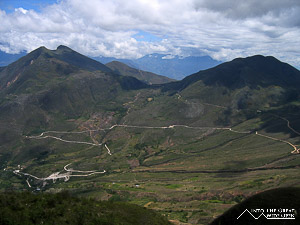Celendin, Peru
From Leymebamba to Celendin
February 5, 2008
Some days are diamonds, some days are rocks
Some doors are opened, some roads are blocked
Sundowns are golden, then fade away
- Ben Harper

The town of Leymebamba was a crumbling mess of a place perched up on hillside about two hours south of Tingo. Half of the streets in town had been ripped up for repaving and so all traffic flowed through the one street that passed through the central plaza. At least the town had internet and several restaurants and hotels. From Leymebamba there is transport twice a week to Celendin, about 7-8 hours away. I inquired as to why there wasn´t more frequent transport and the only answer I could get was that Celendin was located in a different province and so demand was low. At least there were transportation options, with a van leaving at 6am and also a bus passing through from Chachapoyas between 8-10am, but with no guarantee of a seat.

With no guarantee of a seat, and knowing the quality of the roads, I decided to take the van and had to drag myself out of bed before dawn to wait for it to arrive. The clerk at the hotel had reserved a spot for me so I just had to wait until about 6:15am when the van finally showed up with a sheep roped to the top. As all the bags and cargo were loaded on, the sheep was moved so that it nestled in snuggly with the spare tire and a tarp was thrown over the other bags on the roof. Inside, the van there was a mobile farm with a sack of live chickens, a sack of guinea pigs, and a woman´s dog. Before we started there was a foul smell in the van and this man handed out a sack of raw meat that had to be placed on the roof, as the stinking raw meat in an unrefrigerated and unsealed bag would have been too much for all the passengers to bear. Finally we were ready to go as the van pulled out of town around 6:30am.

From Leymabamba the road climbed steadily up the mountains from 7,000 feet to the cold and foggy mountain pass at about 11,500 feet. After leaving Leymabamba, there weren´t really any towns, only a few houses scattered here and there, and no electricity either. Most of the hillsides were totally covered in vegetation and it was understandable how some ancient ruins are still being discovered. Past the mountain pass the road dropped continuously for about 3 hours. We emerged from the cold, damp fog of the high mountains to an elevation in between the clouds with more clouds above and clouds and fog below. The views were just amazing and I was lucky enough to get a few decent pictures as the van rumbled along the poor and potholed road. Still moving downhill we stopped for breakfast at about 9:30am at a restaurant on the side of the road, and by restaurant I mean a mud brick hut with three women cooking on a mud brick stove over a wood fire.

The food was fresh and very tasty, bringing a whole new meaning to organic. I had the soup, which had various animal parts in it, some stomach, intestines, heart, and I was lucky enough to get a big hunk of brain as well, I also had a plate of stir fried beef with vegetables, rice, and an egg, all for two dollars. After eating we pressed on downhill passing into dry and desert scenery with some stunning mountains and a glimpse of the road on the other side of the river valley. Occasionally the driver would stop at some homes to drop some things off and collect mail and money for things that he would deliver on his return journey the next day. I found it strange that there were people living so far out in the middle of nowhere with no electricity in mud brick houses, relying on the driver as their only link to the outside world; it was quite amazing really.

Finally, after four and a half hours we finally reached the town at the river, Balsas, which had electricity, and at 2,500 feet marked the bottom of our descent of 9,000 feet. We dropped of a few people and picked up a few people and then rambled across the river and headed up the other side of the mountains on a long and winding road, leaving the desert behind as we climbed. Mid-way up the mountains we stopped at a house and they promptly brought out three five gallon buckets and a funnel. That´s right, no gas stations out here either. After re-fueling and much climbing we reached the next mountain pass at 10,000 feet. After 6 hours the end was not far off, another 2,500 feet down the other side of the pass to reach the town of Celendin. From Celendin I caught another van to Cajamarca, about 4 hours away on a very rough and deeply potholed road. A long day of traveling had finally come to an end. I must say that after all the 199 hours I have spent of buses, boats, and trains so far; the scenery on the trip from Leymabamba to Celendin was by far the best.



























































